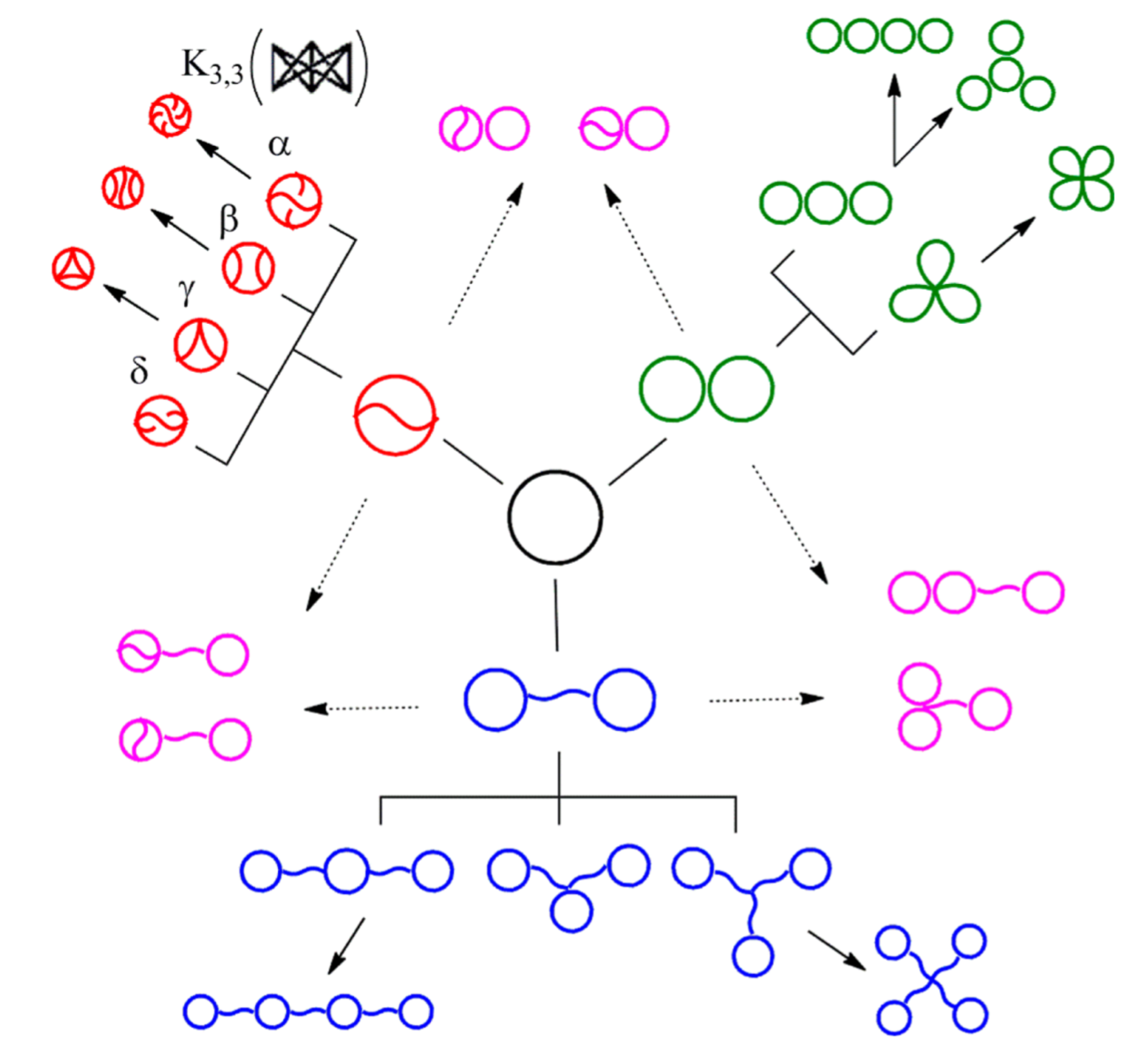Random Graph Embeddings with General Edge Potentials
/css21
This talk!

Collaborators


Jason Cantarella
U. of Georgia
Tetsuo Deguchi
Ochanomizu U.
Erica Uehara
Ochanomizu U.
Funding: Simons Foundation
Linear polymers
A linear polymer is a chain of molecular units with free ends.
Polyethylene


Nicole Gordine [CC BY 3.0] from Wikimedia Commons
Shape of linear polymers

In solution, linear polymers become crumpled:
Protonated P2VP
Roiter–Minko, J. Am. Chem. Soc. 127 (2005), 15688-15689
[CC BY-SA 3.0], from Wikimedia Commons
Topological polymers
A topological polymer joins monomers in some graph type:

Petersen graph
Synthetic topological polymers

The Tezuka lab in Tokyo can now synthesize many topological polymers in usable quantities
Y. Tezuka, Acc. Chem. Res. 50 (2017), 2661–2672
Main Question
What is the probability distribution on the shapes of topological polymers in solution?
Ansatz
Linear polymers
Topological polymers
Random walks with independent steps
Random walks with steps conditioned on ???
Graphs and the Graph Laplacian
Suppose \(\mathcal{G}\) is a directed graph with \(\mathbf{v}\) vertices and \(\mathbf{e}\) edges.
\(L:\mathbb{R}^{\mathbf{v}}\to \mathbb{R}^{\mathbf{v}}\) given by \(L = \partial \partial^T\) is the graph Laplacian.

Think of \(x=(x_1,\dots,x_{\mathbf{v}})\in \mathbb{R}^{\mathbf{v}}\) as a realization of \(\mathcal{G}\) in \(\mathbb{R}\).
Harmonic bonds \(\Rightarrow\) Gaussian vertex distribution:
Realizations

This is James–Guth–Flory phantom network theory!

Some More Careful Linear Algebra
Define \(\widetilde{L}:=L+\frac{1}{\mathbf{v}} \mathbf{1}\mathbf{1}^T\).
Proposition.
- \(\partial:(\operatorname{EC},\langle \cdot,\cdot\rangle) \to (\operatorname{VC},\langle \cdot,\widetilde{L}^{-1}\cdot\rangle)\) is a partial isometry.
- \(\partial:(\operatorname{VP},\langle \cdot,\widetilde{L}^*\cdot\rangle)\to(\operatorname{ED},\langle\cdot,\cdot\rangle)\) is a partial isometry.
Radius of Gyration
\(\mu_{\mathcal{G}}\): \(O(d)\)-invariant measure concentrated on \(\operatorname{im}\partial^* \subset \operatorname{ED}\)
\(\nu_{\mathcal{G}}=(\partial^{*+})_\sharp \mu_{\mathcal{G}}\), its pushforward to \(\operatorname{VP}\).
\(\Sigma_{\mathbf{v}}:=\) matrix of expectations of products of a fixed coordinate of the vertices of \(\mathcal{G}\)
\(\Sigma_{\mathbf{e}}\) likewise for edges.
Theorem. The expected radius of gyration is
\(\langle \operatorname{R}_g^2\rangle_{\nu_{\mathcal{G}}} = \frac{d}{\mathbf{v}}\operatorname{tr}(\Sigma_{\mathbf{v}}) = \frac{d}{\mathbf{v}} \operatorname{tr}(\partial^{T+}\Sigma_{\mathbf{e}}\partial^+)\)
When \(\mu_{\mathcal{G}}\) is a standard Gaussian on \(\operatorname{im}\partial^*\),
\(\langle\operatorname{R}_g^2\rangle_{\nu_{\mathcal{G}}}= \frac{d}{\mathbf{v}}\operatorname{tr}\partial^{T+}(\partial^T\partial^{T+})\partial^T = \frac{d}{\mathbf{v}} \operatorname{tr} \partial^{T+}\partial^T = \frac{d}{\mathbf{v}} \operatorname{tr}L^+\).
Subdivisions




Chain Maps
Main Theorem
Theorem. Suppose \(f_0\) and \(f_1\) are injective chain maps between graphs \(\mathcal{G}'\) and \(\mathcal{G}\) of the same cycle rank. Given \(O(d)\)- and translation-invariant \(g:\operatorname{VP} \to \mathbb{R}\) which is expressible in terms of \(\mathcal{G}'\), then
\(\mathcal{E}_{\nu_{\mathcal{G}}}(g) = \mathcal{E}_{\nu'_{\mathcal{G}'}}(g')\).

Consequences


\(\mathcal{G}\)
\(\mathcal{G}_n\)
Proposition. In phantom network theory, the joint distribution of squared distances between junction vertices in \(\mathcal{G}_n\) is the joint distribution of \(n\) times the squared distances between vertices in \(\mathcal{G}\).
Consequences

In the freely-jointed chain, each edge is a unit vector.
\(\langle \operatorname{squared\, junction-junction\, distance}\rangle_{\nu_{\mathcal{G}_n}}\) is in principle an \((18n-12)\)-dimensional integral
Using the theorem, can reduce to a \(6\)-dimensional integral.

Questions
What about including distributions on bond angles in addition to bond lengths?
Sampling algorithms?
Steric constraints and the complete graph?
Thank you!
References
J. Cantarella, T. Deguchi, C. Shonkwiler, E. Uehara, Gaussian random embeddings of multigraphs, preprint, 2020, arXiv:2001.11709
J. Cantarella, T. Deguchi, C. Shonkwiler, E. Uehara, Radius of gyration, contraction factors, and subdivisions of topological polymers, preprint, 2020, arXiv:2004.06199
J. Cantarella, T. Deguchi, C. Shonkwiler, E. Uehara, Random graph embeddings with general edge potentials, preprint, 2021, on arXiv soon!